Archive for July 2005
Gion Matsuri Maiko: Makiko
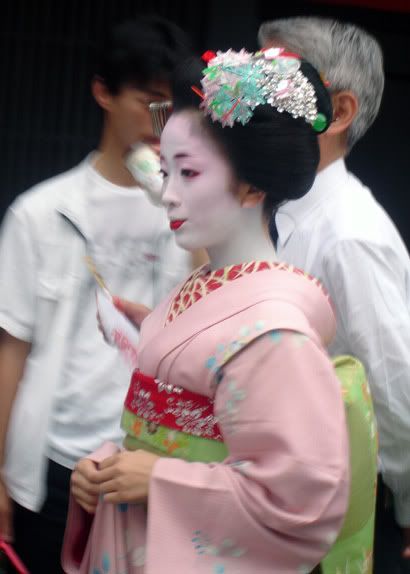
This is young Makiko, a maiko from Gion, on her way to watch the Procession of Dieties with her patron, the mop of grey hair hidden behind her glossy black lobes. The swarms of people gather along Shijo-dori parted like the Red Sea as gracefully glided towards the shrine. This is Makiko's first or second Gion matsuri as a Maiko! Her upper lip is still covered in the white makeup that overs the rest of her face, and her collar is still predominantly red. As she advances in skill and experience, she will be able to paint her upper lip in deep crimson, while her collar will gradually become less ornate, until she becomes a Geiko.
Gion Matsuri: Procession of Dieties
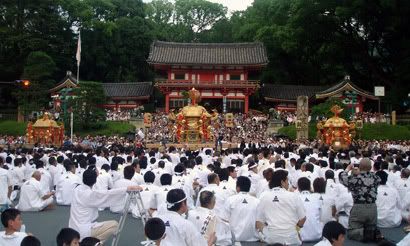
Ususally the only shot of Yasaka Shrine one can get is with a few ugly buses, taxis and cars streaking thru the foreground, but with Shijo-dori closed to traffic for the procession, the street is filled with happi-clad mikoshi carriers and lined with excited onlookers. Here, three mikoshi, or portable shrines, rest before Yasaka Jinja (shrine) before being carried by the men in white throughout the streets of Gion.
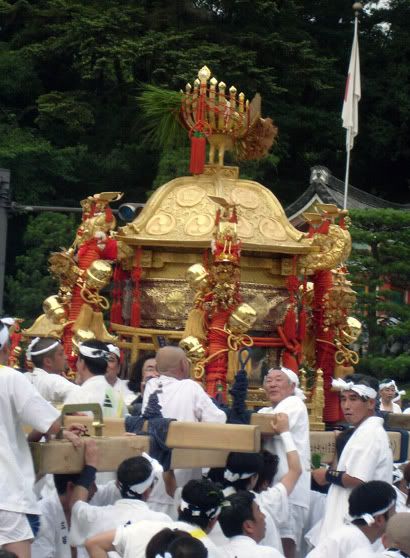
There is something strikingly Biblical about these mikoshi...I remember the first time I saw one at the Kurama Himatsuri during my Gaidai days, I immediately thought of the Ark of the Covenant. I am completely aware that there is a very descriptive description (redundant much?) of the Ark in the Bible, and that is it very different from what you see before you here, but the thread that joins all of mankind and its history together is, for me, blatantly aparant in these ancient traditions. You can't tell me that the ornamentation on the roof of the mikoshi doesn't look like a menorah!
Unlike the festival hoko floats, Mikoshi are not pulled, but carried on the shoulders of many men. Not only are they carried through the streets of the city for hours, they are thrown into the air and jostled about to excite the crowd. After bouncing the Mikoshi down Shijo a bit, these men made a turn onto the Hanamikoji, "Wasshoi"-ing their way past the Ichirikiya, the most famous Ochaya ( 'teahouse', where Geisha and maiko entertain) in the history of Japan...
Gion Matsuri: Yamahoko Junko
The History of Gion Matsuri
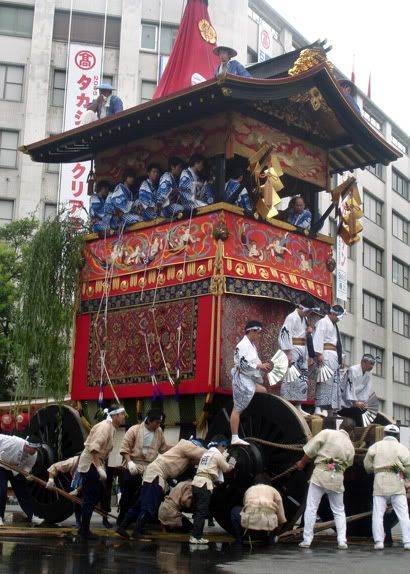
Gigantic floats gradually turn on smooth, green, bamboo logs, split in half and laid out on the rough cement. The crowds cheer with excitement and burst into applause every time the massive Yamahoko turn the corner with the thunder of creaking wheels.

Gion Matsuri did not begin as the joyous celebration it is today. Its story beins in the year 869, as a deadly epidemic devastated the empire. The Shinto diety Gozu Tenno, also known as Gion, was known for his healing power and protection of its followers, as well as the power of transferability via sacred carriages. Seeing the plague as a punishment for impiety, Emperor Seiwa sent his messengers to Gion Shrine (now known as Yasaka,) to pray for relief, and ordered 66 floats to be erected, one for each province of Japan.
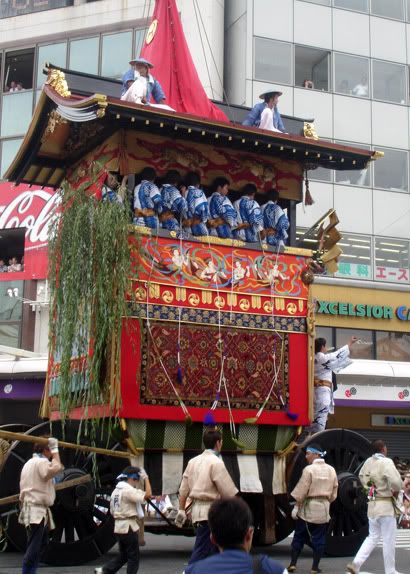
They were paraded thru the streets, purifying the city, until they arrived at Gion shrine (Yasaka), where prayer rituals were performed to expel the epidemic. Miraculously, the plague ended .
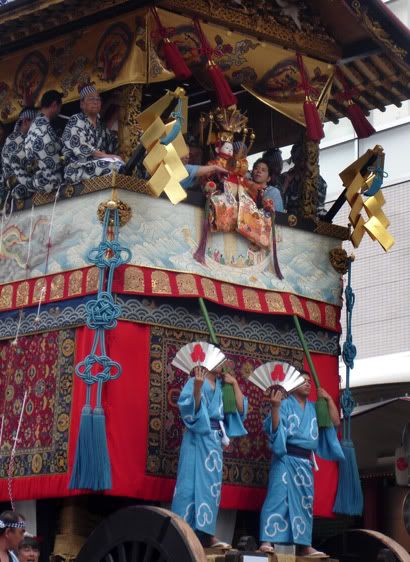
From that point on, whenever a plague broke out, the ritual was repeated. It did not become an annual event until 970, by which time the festival had become an integral part of the townspeople's lives, each year more elaborate than the first. When the Muromachi shogunate halted all religious events in 1533, the townspeople resisted strongly, declaring in true Japanese fashion that they could do without the rituals, but not the procession.
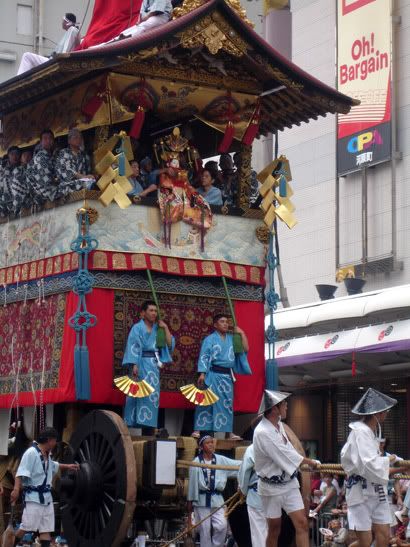
Gion Festival as we know it today began to take shape in the 1600's. By then it’s religious origins had been eclipsed by the prosperity of the people, becoming a a showcase of the wealth and splendor of Kyoto’s merchant class. As trade expanded beyond the land of the rising sun, imported tapestries from China, Korea, Persia, the Netherlands, and France, along with Nishijin tapestries, the finest in Japan, began to adorn the festival floats, giving the festival a unique international air.
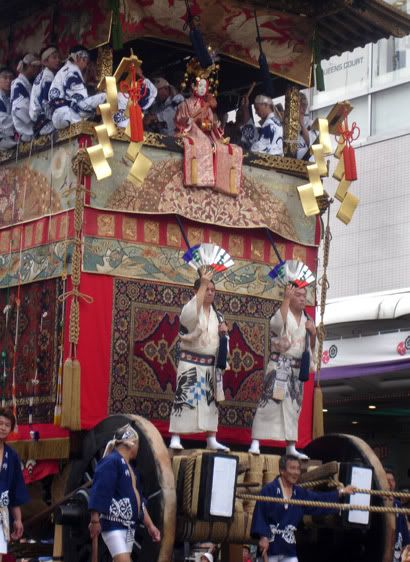
This year the parade fell on a Sunday for the first time in 11 years. The number of spectators reached about 240,000 according to the Kyoto Prefectural Police, tying with the record number of spectators recorded in 1989.
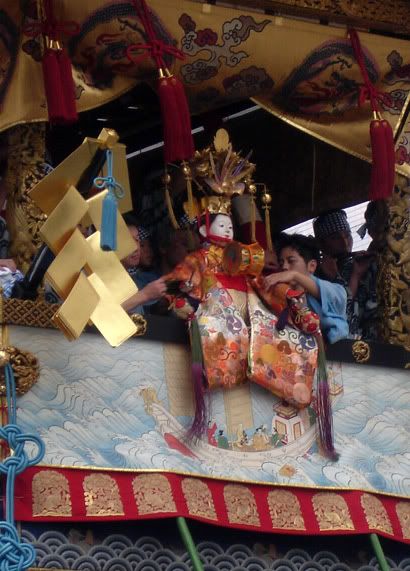
The Chigo, or sacred child, acts as an intermidary between the gods and the people. During the procession the Chigo is not allowed to touch the ground, and must be carried by other men. Traditionally, Chigo rode on all Gion Festival floats except the Fune-boko. However, towards the end of the Edo Period, this practice stopped, and children were gradually replaced by dolls. Nowadays, only the Naginata-boko keeps the tradition of having children ride aboard it.
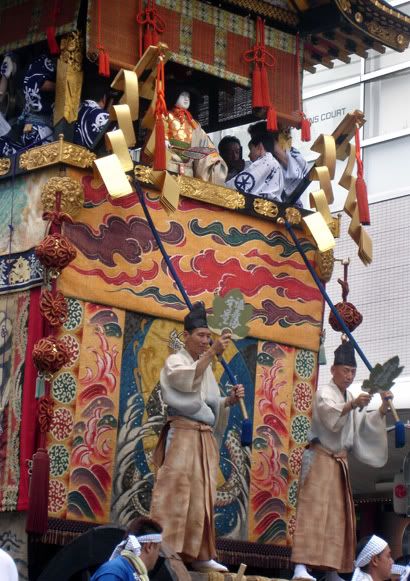

Every community in Gion has its own float, owned by a wealthy merchant family, that has been passed down thru the centuries. The members of each community can be distinguished by their happi or yukatas, decorated with the community crest or kanji design.

This is a hoko. Hoko weigh about 12,000 kg and stand at about 8 meters from ground to roof, not to mention the poles at the top, which reach about 25 meters. Before the parade, a crew of workers came down the street turning all street lights and signs off the road so as not to interfere with their procession. I was suprised as this floak creaked slowly past me to reveal an extremely modern looking (art deco style) tapestry decorated with a Christian Cathedral design, a cross at the heart of the composition.
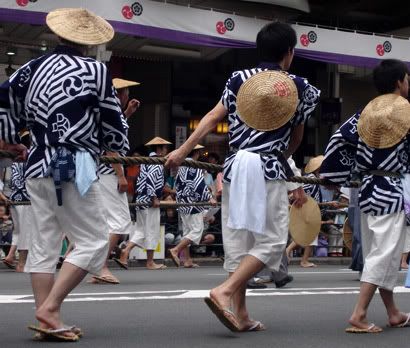
They are pulled by between 30 and 40 people with long ropes.
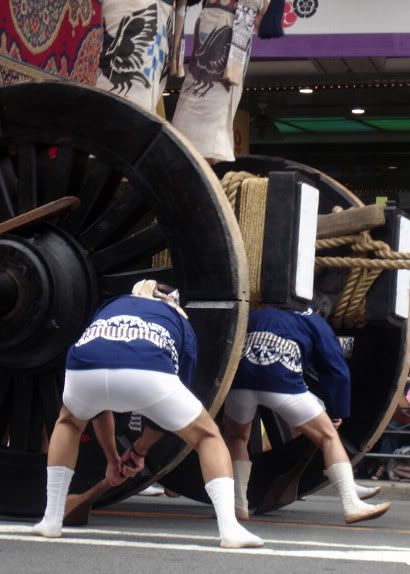

These guys try to keep the wheels spinning wihtout getting run over or losing any limbs. The carriages are still constructed in traditional sacred fashion,without nails. Everything is held together with elaborate roping techniques and interlocking wood.
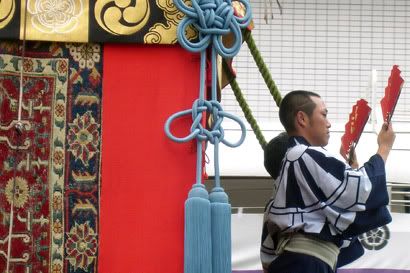
Two pilots stand on a running board at the front of the float to guide it (four when turning,) and four roof lookouts keep the mast steady and clear of obstructions, such as power lines.

Check out the beautiful Castle design...not exactly tradtional Japanese! It must have been even more exciting for the internationally isolated people of Japan to see the imported tapestries of places and people so different from the one they knew.
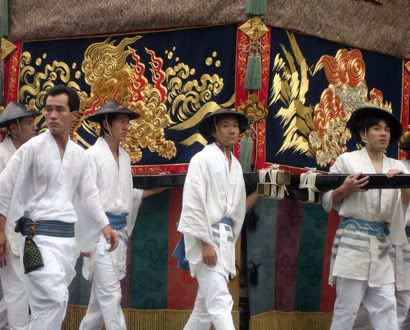
Yama floats are much smaller, and can be pushed, pulled or carried by 14-24 men.
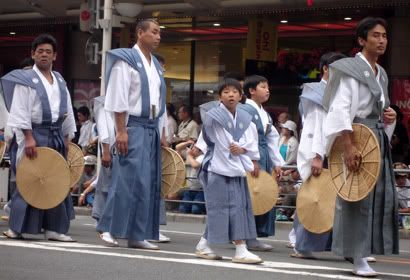
Participants in traditional hakama and straw hats.
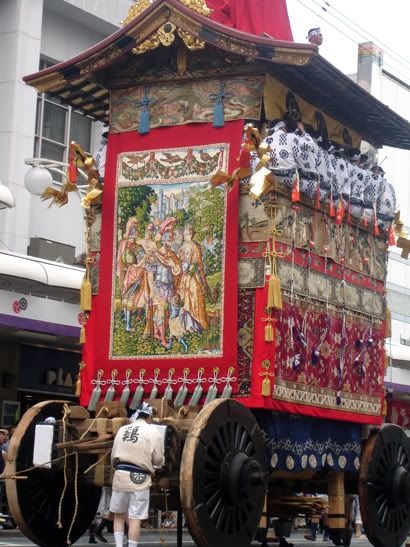

A medeval tapestry depicting the life of royalty and knights in shining armor.
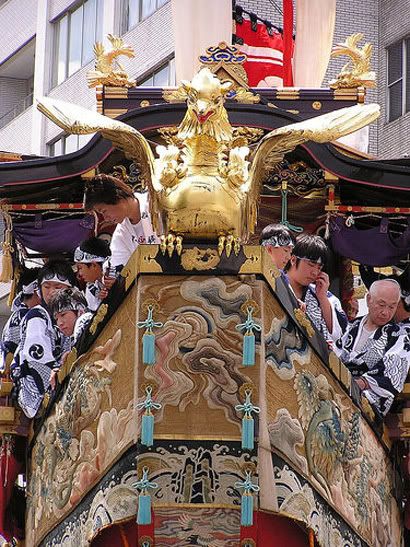

Fune boko, "The Boat Float," is the most unique in the procession, led by a legendary pheonix, the golden Geki.
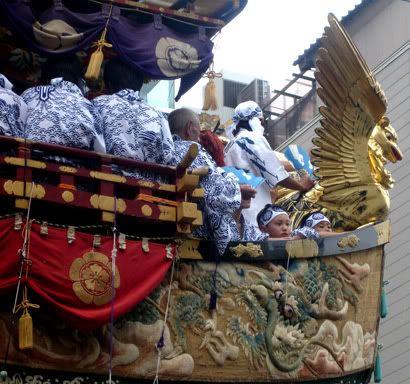
According to Japanese mythology, this float is based on an ancient ship used by the Japanese empress, Jingu Kogo, reputed have conquered three Korean kingdoms - Silla, Kokuryo and Pekeche, while pregnant with the future emperor. Japanese women still pray to Kogo Jingu for safe delivery. Because of her success in the war, she is also regarded as the Goddess of War.
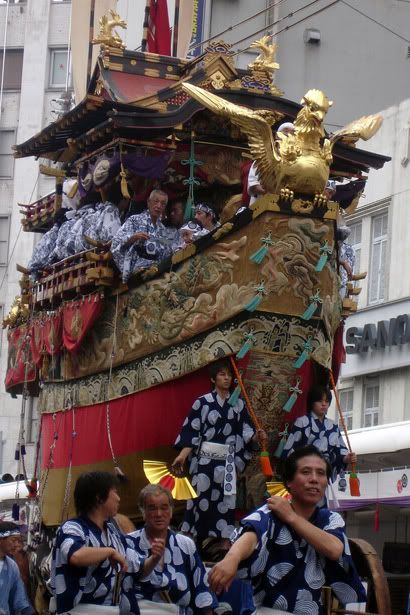

The main figures in this float are Empress Jingu Kogo and Ryujin - the Japanese dragon god of the sea (one of the figures shown in the picture). According to legend, Ryujin controls the tidal flow with hismagical Tide Jewels. Prior her invasion of Korea, Empress Jingu Kogo prayed to Ryujin, who granted her the magical Tide Jewels. The Japanese fleet set sail towards Korea, and the Korean fleet sailed out to confront them. When she saw the approaching fleet, the empress quickly threw the Low Tide Jewel into the sea so that the tide receded at once and the Korean fleet was beached. The Koreans all jumped out onto the mudflats, and at that moment the empress threw the High Tide Jewel in, and a tidal wave drowned the men and carried the japanese fleet to victory.


Young boys riding on the floats wear stylin' Yukata and play Gion Bayashi, tradtional festival music of flutes and bells.
Despite the fact that I left to secure a seat along the parade route over 2 hours before it began, thousands of people were already camped out at the corners of Shijo and Karasuma when I arrived. Luckily I found a spot just down from the corner sitting on the street, so I was still able to see the hoko make their death-defying turns. (I say 'I' because my fantastic travel buddy, JBlo, slept in and met me afterwards). Note to self: Next year be prepared to head for Karasuma at the crack of dawn! And get a decent camera, not to mention a cooler travel buddy! Nothin' but love Jblo! (^.^)/
Kyoto's Gion Matsuri : Yoiyama
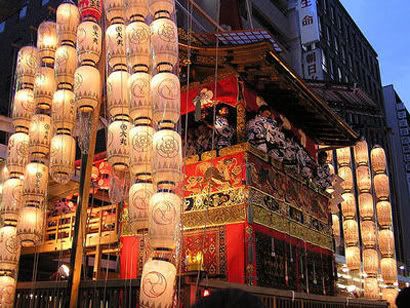
Gion Matsuri is one of the biggest, most famous, and most beautiful festivals in Japan. Although the festival actually lasts the entire month of July, the climax is the Procession of Floats on July 17. For a few nights leading up to Yama Hoko Junko, the people of Gion display their magnificent festival floats and priceless family treasures, handed down from generation to generation for hundreds of years.
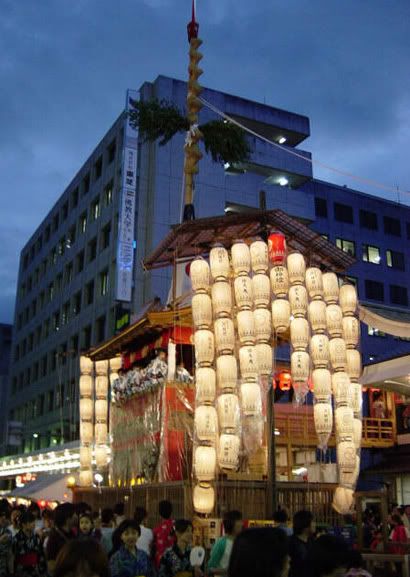
As the sun disappears behind the mountains that embrace the city, the soft light of paper lanterns sets the floats a glow. The kon-chiki-chin of Gion bayashi (traditional festival music of Gion) mingles with the sound of traditional flutes dancing on the Kyoto air, thick with the chants of young men pulling mikoshi (portable shrines) and the ringing of the bells that dangle down on each side of the floats. Dressed in yukata, a summer kimono made of cotton, geta, high wooden sandals, and traditional festival regalia, the people that fill the streets only add to the heavy sense that if only for tonight, Kyoto is the same today as it was over a thousand years ago, when this festival began.
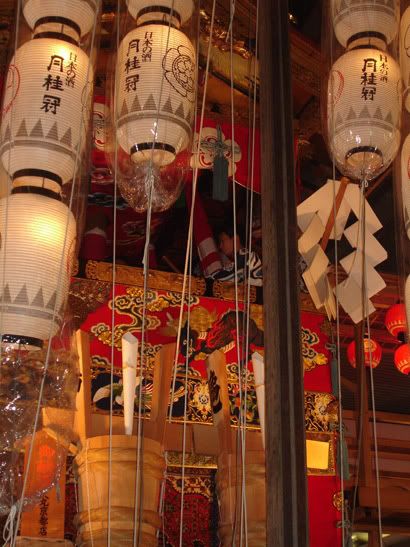
We arrived in Kyoto the night of Yoiyama, the eve of the big procession. Jen, the High school ALT in Ena, had never been up to Kiyomizudera, so I took her on a walking tour of Higashiyama. The narrow roads up to the temple were begining to fill with brightly colored yukatas, and the clip-clop of geta on the stone-paved roads echoed in the alleyways.
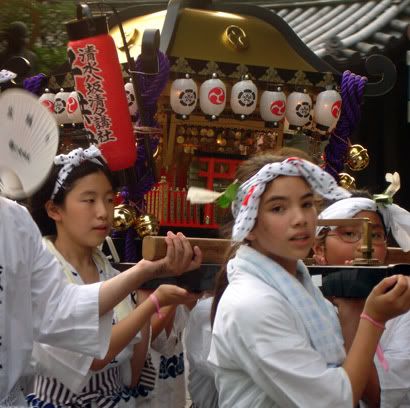
As we headed back towards Shijo, the main avenue, the sound of festival flutes and chants of "Wa-shoi! Wa-Shoi!" filled the air. Near Kodaiji (temple) we came across school of elementary school students, preparing to make their runs with their own Mikoshi (portable shrine).


Festival participants wear happi, traditional festival gear something like a short yukata decorated with the emblem of their group (neighborhood, school, club...).

Maruyama Koen was a romantic refuge from the bustle of the busy streets. Many couples, dressed in yukata, sought shelter beneath the famous cherry trees as they shared snow cones, a summer festival favorite.

Maruyama Koen was a romantic refuge from the bustle of the busy streets. Many couples, dressed in yukata, sought shelter beneath the famous cherry trees as they shared snow cones, a summer festival favorite.

Yasaka Shrine, once known as Gion Shrine and namesake of the festival, was full of stylish spectators seeking a glance of the sacred mikoshi. (The man above is wearing geta, high, wooden sandals.)
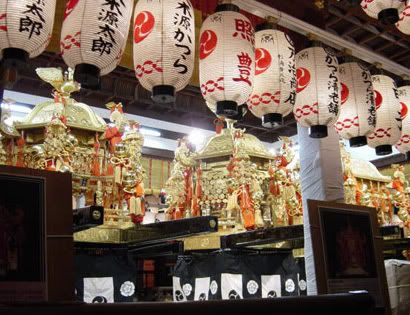
The sacred mikoshi, at rest at Yasaka Shrine.

The sacred mikoshi, at rest at Yasaka Shrine.
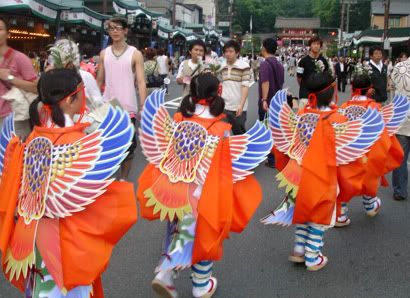
A flock of exotice birds head for Yasaka shrine.
When we finally made it down to the main Avenue, the streets had already been closed to traffic, and were steadily filling with a constant stream of spectators and participants. As we waked towards Minamiza, I noticed a stage set up near the Starbucks just before the Hanamikoji, the most famous street in Gion. The banners hanging in the background read " Maiko, Geisha, Kyomai." All my kanji study had finally payed off! Check out my next post to see those pictures!
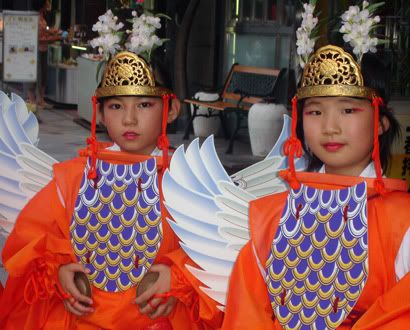
These elementary students preformed a sacred dance in full regalia.


Unfortunately I missed while watching the geiko and maiko dance!
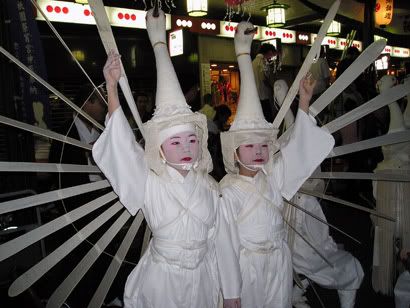

The Swan Dance is another sacred dance performed by young children.
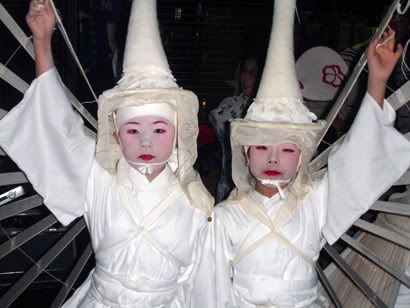
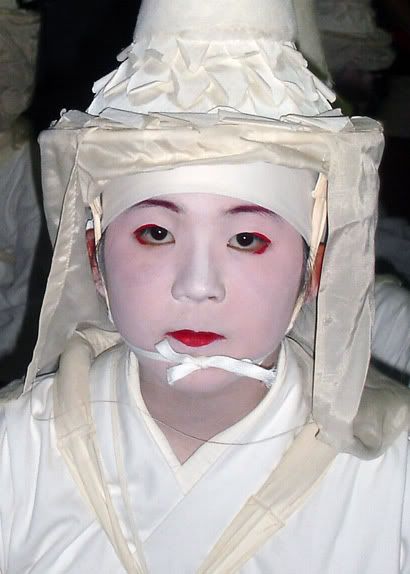
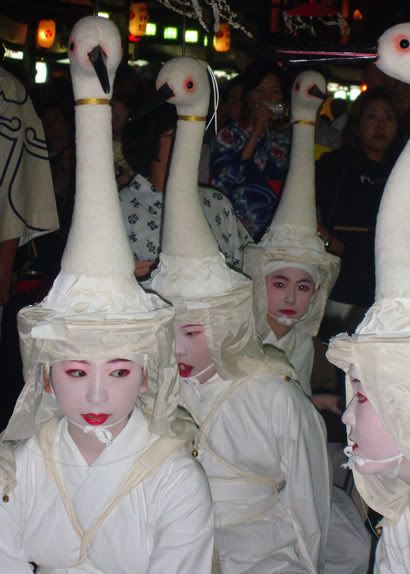
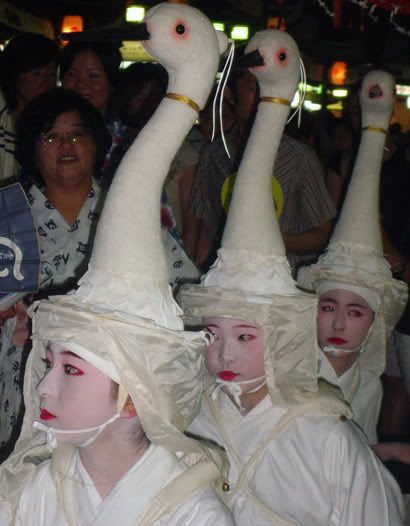












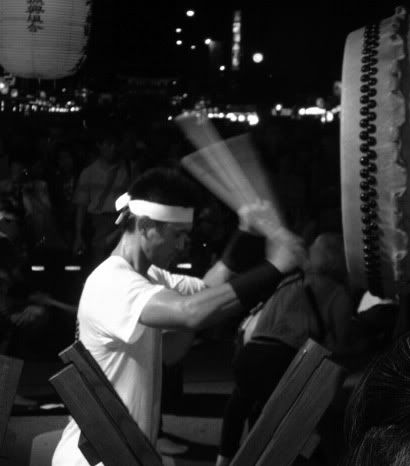
After the swan dance, a taiko group performed. They were awesome! Taiko is the art of playing a Japanese Drum with exaggerated, theatrical movements. Aside from the awesome beat, its really exciting to watch! Lindz and I got really excited and started talking about how awesome this guy was, and a little old obaasan (grandma lady) turned around and shushed us, finger to the lips, librarian style! Those little obaasans have some nerve yo! I'm sure we were almost interupting the performance, consisting of atleast 15 drums, not to mention the thousands of sake-sipping spectators and mikoshi crews chanting on their rounds of the city!
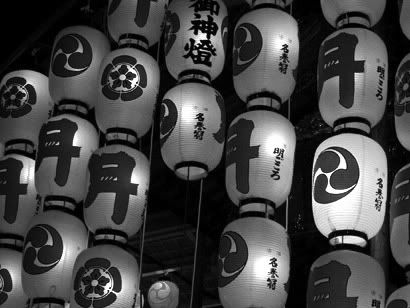
After watching the swan dance, we wandered thru the lantern-lit side streets admiring the floats, family treasures, and festival food. We came across more than a few Maiko, but that's for another post!

Ever since I first came to Japan and heard about Gion Matsuri, it has been at the top of my list of things to do here. As we wandered the streets, casually strolling past maiko, geisha, and their yakuza (Japanese Mafia) patrons, watching young girls in brightly colored kimono chat on perfectly accessorized ketai (cell phones), inhaling the mix of takoyaki (octopus dough balls), yaki soba, and squid on a stick, I can't imagine there is anywhere else I would have rather been. With total disregard for the sacred train timetable, we meandered thru the narrow sidestreets, glowing with the lantern light of the festival floats.
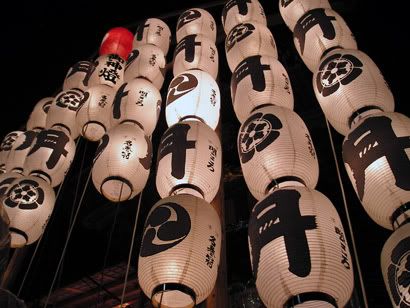
Some how we made the last train back to Shichijo, even though first we got off at the wrong stop and had to hop back on the next train. Before leaving Shijo, which had been magically transformed for the event, the streets reopened and the crowds slowly shifted to the sidewalk. As we tred towards the subway station, a fleet of Japanese deko trucks and pimp mobiles slowly rolled by, bouncing to the beat of Japanese hip-hop. Not exactly the kon-chiki-chin of Gion Bayashi. Once again the juxtoposition of ancient custom and ultra-modern sensitivities left me feeling like the night had been nothing more than a dream.
A dream in which I lost the key to the hostel, still got in the door, but was forced to try to sleep (I failed) in the brightly-lit lounge, the sweat of a day hiking around Kyoto crystalizing on my sun kisssed skin. Luckily I planned to wake up early the next day to get a decent spot on the parade route...
So Long Tsuyu! さよなら 梅雨!

I think Tsuyu has finally come to and end. I will miss playing in the warm, summer plum rain, and sleeping with the cool breeze it brings. From here on out its pure hotness. Unsleepable, sweat-saturating, sun-hazy hot.
For now I will live in denial of the approaching death-by-sweaty, sleepless nights, and focus on Gion Matsuri (The most famous festival in Kyoto, in which I will be partaking this weekend)!
In the spirit of Gion, and Geisha everywhere, I offer this photo as a final farewell to the rain (plum rain, anyways)!
Sayonara Tsuyu!
For now I will live in denial of the approaching death-by-sweaty, sleepless nights, and focus on Gion Matsuri (The most famous festival in Kyoto, in which I will be partaking this weekend)!
In the spirit of Gion, and Geisha everywhere, I offer this photo as a final farewell to the rain (plum rain, anyways)!
The Joys of Japan: Engrish
Also known as Japlish or Japanglish, Engrish is the Japanification of the English language. Its use in Japanese advertisement and graphic design provide a constant source of comic relief for those of us in Japan that can or care to read it ( let alone try to understand what it's all about) .
In the words of Matsumo, Japanese High School English Teacher Extrordinaire, 'the English language is used for fashion, not for communication, here in Japan!'
Why Engrish? Well, phonetically, the Japanese language has no hard 'r' sound. Instead they use a very soft r-l combo, which results in their inability to discern the difference between the two sounds (Unless, of course, they are repeatedly exposed to it, and taught to recognize the difference. That's where I come in!) One famous example of this confusion is rice and lice. The most famous, of course, is Engrish.
Let's Enjoying Engrish!










Osaka Bound! 大阪へ!
Yuko (one of my best friends from Kansai Gaidai) and I in front of Namba's Neon wall, with the famous Glico Running Man (Glico is a Japanese candy company).
I'm headed for Osaka this weekend to say Sayonara to Lindz, fellow maiko wannabe, and general Japan-land partner in crime, ready to repatriate herself after a year of teaching for Nova.